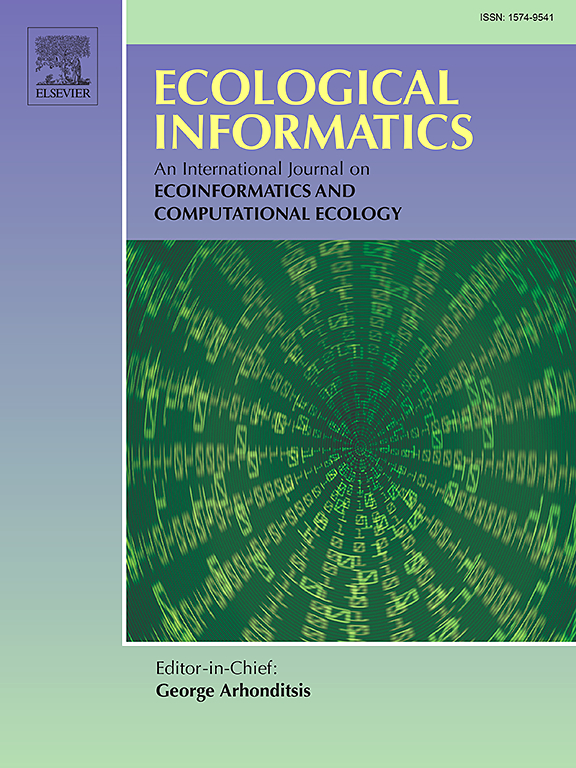Capturing constraints on boreal gross primary productivity using the remote sensing-based CAN-TG model.
IF 5.8
2区 环境科学与生态学
Q1 ECOLOGY
引用次数: 0
Abstract
In response to the limited number and distribution of in-situ carbon flux observations, remote sensing-based methods are increasingly relied upon for the estimation of Gross Primary Productivity (GPP) at regional to global scales. These remote sensing-informed estimates are commonly derived through process-based modelling frameworks which prescribe functional relationships between model inputs and target GPP. Across highly heterogeneous landscapes like the Canadian boreal, these parameters are difficult to constrain and often site-specific. Recent work has determined that parameterization alone may not improve model performance, instead requiring additional model inputs to capture the complex drivers of vegetation productivity across land cover types. In response to these challenges, we applied the remote sensing-based CAN-TG framework to estimate boreal GPP, leveraged through a random forest (RF) machine learning approach that does not assume linear or functional relationships between input variables and productivity. Stratified by land cover, fire disturbance history, and topography, models were assessed for their ability to capture reference GPP from NASA's complex, process-based Soil Moisture Active Passive (SMAP) GPP product. Across all boreal strata, model r2 values ranged from 0.93 to 0.96, demonstrating that the variability in substantially more complex models can be successfully captured using a simple, interpretable remote sensing-based framework. Through the addition of remote sensing variables capturing freeze/thaw and soil moisture dynamics to surface temperature and greenness, the CAN-TG model demonstrated an improved ability to capture GPP compared to a benchmark GPP model. Seasonal RF models across key boreal land cover, fire disturbance history and topographic strata further demonstrated varying and complex non-linear relationships between model variables and GPP. Spring and fall models generally outperformed winter and summer models, reaffirming model strengths whilst also highlighting remaining uncertainty and areas for future model improvement.

利用基于遥感的CAN-TG模型捕捉北方总初级生产力的约束条件。
由于原位碳通量观测的数量和分布有限,基于遥感的方法越来越多地用于估算区域到全球尺度的总初级生产力(GPP)。这些基于遥感的估计通常是通过基于过程的建模框架得出的,该框架规定了模型输入与目标GPP之间的功能关系。在像加拿大北方森林这样高度异质的景观中,这些参数很难约束,而且通常是特定于场地的。最近的工作已经确定,单独参数化可能不会提高模型的性能,而是需要额外的模型输入来捕捉不同土地覆盖类型的植被生产力的复杂驱动因素。为了应对这些挑战,我们应用基于遥感的CAN-TG框架来估计北方地区的GPP,通过随机森林(RF)机器学习方法进行利用,该方法不假设输入变量与生产力之间存在线性或函数关系。根据土地覆盖、火灾干扰历史和地形进行分层,评估了模型从NASA复杂的、基于过程的土壤湿度主动被动(SMAP) GPP产品中获取参考GPP的能力。在所有北方地层中,模型r2值范围为0.93至0.96,表明可以使用简单、可解释的基于遥感的框架成功捕获更复杂模型中的变率。通过将捕获冻融和土壤水分动态的遥感变量添加到地表温度和绿度中,CAN-TG模型显示出比基准GPP模型更好的捕获GPP的能力。基于关键北方土地覆盖、火灾干扰历史和地形地层的季节性RF模型进一步表明,模型变量与GPP之间存在复杂的非线性关系。春季和秋季模型普遍优于冬季和夏季模型,重申了模型的优势,同时也强调了未来模型改进的不确定性和领域。
本文章由计算机程序翻译,如有差异,请以英文原文为准。
求助全文
约1分钟内获得全文
求助全文
来源期刊

Ecological Informatics
环境科学-生态学
CiteScore
8.30
自引率
11.80%
发文量
346
审稿时长
46 days
期刊介绍:
The journal Ecological Informatics is devoted to the publication of high quality, peer-reviewed articles on all aspects of computational ecology, data science and biogeography. The scope of the journal takes into account the data-intensive nature of ecology, the growing capacity of information technology to access, harness and leverage complex data as well as the critical need for informing sustainable management in view of global environmental and climate change.
The nature of the journal is interdisciplinary at the crossover between ecology and informatics. It focuses on novel concepts and techniques for image- and genome-based monitoring and interpretation, sensor- and multimedia-based data acquisition, internet-based data archiving and sharing, data assimilation, modelling and prediction of ecological data.
 求助内容:
求助内容: 应助结果提醒方式:
应助结果提醒方式:


